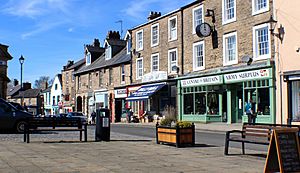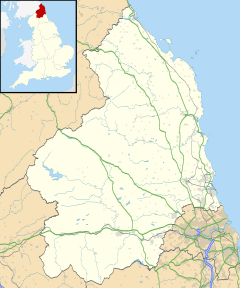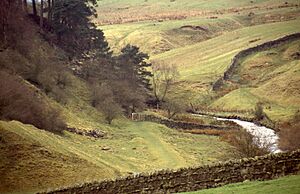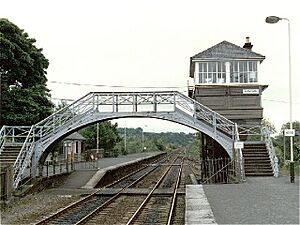Haltwhistle facts for kids
Quick facts for kids Haltwhistle |
|
|---|---|
 Haltwhistle market place |
|
| Population | 3,811 (2011) |
| OS grid reference | NY706640 |
| Civil parish |
|
| Unitary authority |
|
| Ceremonial county | |
| Region | |
| Country | England |
| Sovereign state | United Kingdom |
| Post town | HALTWHISTLE |
| Postcode district | NE49 |
| Dialling code | 01434 |
| Police | Northumbria |
| Fire | Northumberland |
| Ambulance | North East |
| EU Parliament | North East England |
| UK Parliament |
|
Haltwhistle is a lively market town in Northumberland, England. It's about 23 miles (37 km) east of Carlisle and 37 miles (60 km) west of Newcastle upon Tyne. In 2011, around 3,811 people lived here.
Haltwhistle is super close to two amazing places: Hadrian's Wall and Northumberland National Park. Both are only about 2 miles (3 km) away!
Contents
What's in a Name?
The name Haltwhistle might sound like a train stop, but it's not! It comes from much older words.
The second part, -twistle, means "two streams" or "rivers." It describes a high piece of land where two streams meet.
The first part, Halt-, probably comes from an old word meaning "hill-top." This fits because the oldest part of Haltwhistle was built on a hill. This hill was surrounded by the Haltwhistle Burn stream and the River South Tyne.
So, Haltwhistle likely means "the high hill by two rivers" or "the watch on high."
Haltwhistle's History
Haltwhistle has a long history, possibly even dating back to Roman times. It's near the River South Tyne, which was important for the Romans. The old Roman road called the Stanegate passes just 2 miles (3 km) north of the town. This road was built even before Hadrian's Wall!
For many centuries, Haltwhistle and the surrounding areas faced constant attacks. Both English and Scottish groups would raid the town. For example, in 1598, the Armstrongs from Liddesdale attacked and robbed Haltwhistle. Another raid in 1601 saw Scots take prisoners and goods. These events led to long-lasting feuds between families.
In the 1690s, a traveler named Celia Fiennes visited Haltwhistle. She found the local inns and cottages quite basic. She described smoky rooms and simple beds, showing how different life was back then!
A kind lady named Dorothy, Lady Capell, left money in her will in 1721 to start a school in Haltwhistle.
The town grew a lot because it was on the main road between Newcastle and Carlisle. It also benefited from the Newcastle and Carlisle Railway line.
Mining and Industry
In the 18th and 19th centuries, Haltwhistle grew thanks to coal mining nearby. It also became a place to load metal ores from mines in Alston Moor to the south.
In 1836, workers quarrying stone for the railway found a copper pot with 63 coins! Three were gold, and 60 were copper. This amazing find is known as the Thorngrafton Hoard. The empty pot can still be seen at the museum at Chesters Fort.
More recently, a factory making paint was a big employer, but it has now stopped large-scale production. Today, local factories make things like plastic bottles and de-icing products.
Haltwhistle Today
In the 21st century, tourism is very important to Haltwhistle. People come to see Hadrian's Wall and enjoy walking and exploring. The town is also easy to reach from Newcastle and Carlisle.
Haltwhistle is perfect for active holidays. You can enjoy walking, cycling, fishing, and climbing. It's surrounded by the Northumberland National Park and the North Pennines.
Early Local Business
Haltwhistle was a busy market town where people traded local goods. In the 18th century, two Quakers started a fabric factory. There were also weaving places. Along the Haltwhistle Burn stream, you would find mills for cleaning and dyeing wool.
If you walk along this stream towards the Roman Wall, you can see signs of old industries. There were quarries, coal mines, and kilns for burning lime. An old business guide from 1822 listed 60 different types of craftsmen and shopkeepers, including clog makers!
The weekly market was held on Thursdays. There were also special fairs on May 14th and November 22nd for buying and selling cattle and sheep.
Famous Places to See
Hadrian's Wall is a huge draw for visitors. The part of the wall closest to Haltwhistle is especially impressive. You can see it stretching eastwards from Crag Lough lake along the top of the Whin Sill.
You can also see the remains of Haltwhistle Castle and several old fortified farmhouses called Bastles. Haltwhistle also claims to be the exact geographic center of Britain! A hotel in town is even called the Centre of Britain Hotel. This claim depends on how you measure it, as other places also claim this title.
A Border Reivers' Peel Tower from the 15th century is now part of the Centre of Britain hotel. The town has five Bastle houses, which were strong, fortified farmhouses.
A few miles away, you can find Blenkinsop Hall and Blenkinsopp Castle. Both are historic buildings. The impressive Thirlwall Castle is also about four miles from Haltwhistle.
Other historic spots nearby include Featherstone Castle, Unthank Hall, Bellister Castle, and Coanwood Friends Meeting House.
The Haltwhistle Viaduct is a large bridge south of the railway station. It was an important part of the old Alston Line.
Other Interesting Features
Many houses in Haltwhistle are built from stone, which gives the town a unique look.
Places of Worship
The Church of the Holy Cross is a beautiful old church below the Market Place. It offers lovely views over the river valley. This church is a Grade II listed building, meaning it's very important historically. It's one of the few early 13th-century churches still used today!
Inside, you can see tombs, including one for a crusader named Thomas de Blenkinsopp who died in 1388. There are also other medieval grave covers for the Blenkinsopp and Thirlwell families.
The church is a great example of a North Country church. It's impressive how it was built in the 13th century. The main part of the church is very spacious. The font from 1676 has some interesting old carvings.
Nearby, in the village of Coanwood, there's a small but historic chapel. It's called Coanwood Friends Meeting House and was a Quaker place of worship. It's still kept as a historical site that visitors can explore.
How Haltwhistle is Governed
Haltwhistle is part of the Hexham area for the UK Parliament. The person who represents this area in Parliament is called the Member of Parliament.
For local matters, Haltwhistle is part of Northumberland County Council. This council manages local services like schools and roads. The Old Town Hall in Haltwhistle is now used as a hair salon!
Media
If you're in Haltwhistle, you can watch local news and TV shows from BBC North East and Cumbria and ITV Border.
For local radio, you can listen to BBC Radio Newcastle, Capital North East, Heart North East, and Hits Radio North East.
The town's local newspaper is the Hexham Courant.
Getting Around
- Railway
Haltwhistle has its own Haltwhistle railway station. It's on the Newcastle and Carlisle Railway, also known as the Tyne Valley Line. This line opened in 1838 and connects Newcastle upon Tyne with Carlisle. The train line follows the River Tyne through Northumberland.
Passenger trains on this line are run by Northern and ScotRail. The line is also very busy with freight trains carrying goods. The railway station is on the south side of town, close to the River South Tyne.
Until 1976, Haltwhistle station was also where a branch line to Alston began. This line was 13 miles (21 km) long. Part of the southern section of this old line has been reopened as a narrow gauge railway. It's called the South Tynedale Railway and runs between Alston and Slaggyford. The group that runs this railway hopes to reopen the entire line from Alston back to Haltwhistle someday!
- Road
The A69 main road connects Carlisle and Newcastle upon Tyne. This road used to go through the edge of Haltwhistle. But in 1997, a new bypass road was opened, so traffic now goes around the town center.





